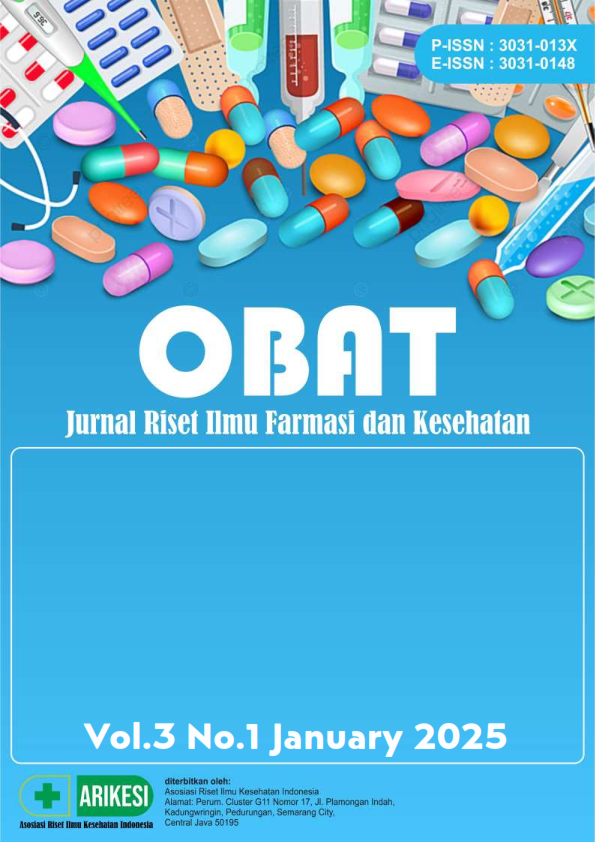Prevalence of Toxoplasmosis Seropositive Antibodies among Children with Autistic Spectrum Disorders (ASD)
DOI:
https://doi.org/10.61132/obat.v3i1.972Keywords:
Autism, Toxoplasma gondi, SeroprevalenceAbstract
Toxoplasma gondi is a pervasive parasite that causes a variety of diseases both in humans and animals, it infects the neural cells of the central nervous system. There have been previous reports linking this infection with Autism. Autism is a combination of complex neurodevelopmental disorders leading to alteration in social communication. This study was done to detect the frequency of seropositive Toxoplasmosis in Autistic children attending psychiatric units in Azady Teaching Hospital in Kirkuk governorate-Iraq. This case-control study was done on 40 Autistic children (30 male, 10 female) with an average age of 5.4±6 years and 40 healthy children (8 male, 32 female) with the same age range (6.1±2) year, from April 2018- January 2020. Sample collection was done by obtaining four ml of blood from all study group children for the detection of both IgM and IgG Toxoplasma gondi antibodies using the ELISA technique. Chi-square and paired T-tests were used for data analysis. The IgM serology for both Autistic and control children was negative while there was just one positive result of T.gondi IgG in Autistic Children and two positive results in normal children which made the result insignificant( X2=0.45, p-value>0.05). Regarding gender, there was no significant difference in detecting positive results between boys and girls of the study groups (X2=0.45 p value> 0.05). The study also demonstrated that Autistic Parents were statistically older than healthy children of the same age. We couldn't uncover any connection between ASD and toxoplasmosis. The age of parents & family history has a significant impact on the development of ASD.
Downloads
References
Abib, R. T., Gaman, A., Dargél, A. A., Tamouza, R., Kapczinski, F., Gottfried, C., et al. (2018). Intracellular pathogen infections and immune response in autism. Neuroimmunomodulation, 25(5–6), 271–279.
Afsharpaiman, S., Khosravi, M. H., Mahmoodinejad, M., Shirbazoo, S., Amirsalari, S., Torkaman, M., et al. (2017). Assessment of Toxoplasma seropositivity in children suffering from anxiety disorders. Iran J Child Neurol, 11(4), 32–37.
American Psychiatric Association. (2013). Diagnostic and statistical manual of mental disorders: DSM-5™ (5th ed.). Arlington, VA: American Psychiatric Publishing, Inc.
Dalimi, A., & Abdoli, A. (2012). Latent toxoplasmosis and human. Iran J Parasitol, 7(1), 1–17.
Dehesh, T., Mosleh-Shirazi, M. A., Jafari, S., Abolhadi, E., & Dehesh, P. (2024). An assessment of the effects of parental age on the development of autism in children: A systematic review and a meta-analysis. BMC Psychology, 12(1), 685.
El-Sayed, S. H., Al-Shewy, K. A. H., Abdin, E. M., & Hasan, H. M. (2024). Seroprevalence of toxoplasmosis among children with autism. The Egyptian Journal of Neurology, Psychiatry and Neurosurgery, 60(1), 42.
Eshraghi, A. A., Liu, G., Kay, S. S., Eshraghi, R. S., Mittal, J., Moshiree, B., et al. (2018). Epigenetics and Autism Spectrum Disorder: Is there a correlation? Front Cell Neurosci, 12, 78.
Flegr, J. (2013). Influence of latent Toxoplasma infection on human personality, physiology and morphology: Pros and cons of the Toxoplasma-human model in studying the manipulation hypothesis. J Exp Biol, 216(Pt 1), 127–133.
Gotteland, C., McFerrin, B. M., Zhao, X., Gilot-Fromont, E., & Lélu, M. (2014). Agricultural landscape and spatial distribution of Toxoplasma gondii in rural environment: An agent-based model. International Journal of Health Geographics, 13(1), 45.
Hassan, Z. R., Zekry, K. M., Heikal, E. A., Ibrahim, H. F., Khirala, S. K., Abd El-Hamid, S. M., et al. (2023). Toxoplasmosis and cytomegalovirus infection and their role in Egyptian autistic children. Parasitol Res, 122(5), 1177–1187.
Idring, S., Magnusson, C., Lundberg, M., Ek, M., Rai, D., Svensson, A. C., et al. (2014). Parental age and the risk of autism spectrum disorders: Findings from a Swedish population-based cohort. International Journal of Epidemiology, 43(1), 107–115.
Mahmood, A. R., Abdulla, A. K., & Hussein, N. M. (2021). Molecular detection of Toxoplasma gondii specific repeat element in blood of recurrent aborted women by real-time PCR. Periodicals of Engineering and Natural Sciences (PEN), 9(4), 708–714.
Morales-Marín, M. E., Castro Martínez, X. H., Centeno Cruz, F., Barajas-Olmos, F., Náfate López, O., Gómez Cotero, A. G., et al. (2023). Differential DNA methylation from autistic children enriches evidence for genes associated with ASD and new candidate genes. Brain Sci, 13(10).
Obaid, H. (2019). Serological and microscopical detection of Toxoplasma gondii in Kirkuk city-Iraq. Serological and Microscopical Detection of Toxoplasma Gondii in Kirkuk City-Iraq, 10, 59–73.
O'Roak, B. J., Vives, L., Girirajan, S., Karakoc, E., Krumm, N., Coe, B. P., et al. (2012). Sporadic autism exomes reveal a highly interconnected protein network of de novo mutations. Nature, 485(7397), 246–250.
Potabattula, R., Prell, A., Dittrich, M., Nava, C., Depienne, C., Bejaoui, Y., et al. (2023). Effects of paternal and chronological age on BEGAIN methylation and its possible role in autism. Aging (Albany NY), 15(22), 12763–12779.
Robert-Gangneux, F., & Dardé, M. L. (2012). Epidemiology of and diagnostic strategies for toxoplasmosis. Clin Microbiol Rev, 25(2), 264–296.
Sadiq, S. F., & Al-Waaly, A. B. M. (2022). The role maternal toxoplasmosis in the development of autism disease in Al-Diwaniyah governorate, Iraq. International Journal of Health Sciences, 6(S6), 10657–10664.
Scott, F. J., Baron-Cohen, S., Bolton, P., & Brayne, C. (2002). The CAST (Childhood Asperger Syndrome Test): Preliminary development of a UK screen for mainstream primary-school-age children. Autism, 6(1), 9–31.
Spann, M. N., Sourander, A., Surcel, H. M., Hinkka-Yli-Salomäki, S., & Brown, A. S. (2017). Prenatal toxoplasmosis antibody and childhood autism. Autism Res, 10(5), 769–777.
Yan, C., Liang, L. J., Zheng, K. Y., & Zhu, X. Q. (2016). Impact of environmental factors on the emergence, transmission and distribution of Toxoplasma gondii. Parasit Vectors, 9, 137.
Ye, Q., Apsley, A. T., Hastings, W. J., Etzel, L., Newschaffer, C., & Shalev, I. (2024). Parental age at birth, telomere length, and autism spectrum disorders in the UK Biobank cohort. Autism Res, 17(11), 2223–2231.
Downloads
Published
How to Cite
Issue
Section
License
Copyright (c) 2025 OBAT: Jurnal Riset Ilmu Farmasi dan Kesehatan

This work is licensed under a Creative Commons Attribution-ShareAlike 4.0 International License.





